Are Ecosystem Services Provided by Street Trees at Parcel Level Worthy of Attention? A Case Study of a Campus in Zhenjiang, China
Abstract
:1. Introduction
2. Materials and Methods
2.1. Study Area
2.2. Ecosystem Service Value: i-Tree Eco Model Application
2.2.1. Tree Data Collection
2.2.2. Hourly Weather Data and Pollution Data
3. Structure and Function
3.1. Street Tree Structure
3.1.1. Importance Value
3.1.2. Age Structure
3.2. Estimation of Ecosystem Services by Street Trees
3.2.1. Carbon Storage and Sequestration
3.2.2. Air Pollutant Removal
3.2.3. Runoff Reduction
4. Results
4.1. Structure of Street Trees at JSU
4.1.1. Species Composition
4.1.2. Importance Values
4.1.3. Age Structure
4.2. Ecosystem Services Provided by Street Trees at Jiangsu University
4.2.1. Carbon Storage and Sequestration
4.2.2. Air Pollutant Removal and Emission of VOCs
4.2.3. Stormwater Runoff Reduction
4.3. Overall Performance of Street Trees on Ecosystem Services
5. Discussion
5.1. Analysis and Recommendations for Strategic Planting of Street Trees
5.2. Ecosystem Service Comparison
5.3. Limitations and Perspectives
6. Conclusions
Author Contributions
Funding
Institutional Review Board Statement
Informed Consent Statement
Data Availability Statement
Acknowledgments
Conflicts of Interest
References
- Brown, R.D.; Vanos, J.; Kenny, N.; Lenzholzer, S. Designing Urban Parks That Ameliorate the Effects of Climate Change. Landsc. Urban Plan. 2015, 138, 118–131. [Google Scholar] [CrossRef]
- Tallis, M.; Taylor, G.; Sinnett, D.; Freer-Smith, P. Estimating the Removal of Atmospheric Particulate Pollution by the Urban Tree Canopy of London, under Current and Future Environments. Landsc. Urban Plan. 2011, 103, 129–138. [Google Scholar] [CrossRef]
- Janhäll, S. Review on Urban Vegetation and Particle Air Pollution—Deposition and Dispersion. Atmos. Environ. 2015, 105, 130–137. [Google Scholar] [CrossRef]
- Yin, S.; Peng, L.L.H.; Feng, N.; Wen, H.; Ling, Z.; Yang, X.; Dong, L. Spatial-Temporal Pattern in the Cooling Effect of a Large Urban Forest and the Factors Driving It. Build. Environ. 2022, 209, 108676. [Google Scholar] [CrossRef]
- Gill, S.E.; Handley, J.F.; Ennos, A.R.; Pauleit, S. Adapting Cities for Climate Change: The Role of the Green Infrastructure. Built. Environ. 2007, 33, 115–133. [Google Scholar] [CrossRef] [Green Version]
- Selbig, W.R.; Loheide, S.P.; Shuster, W.; Scharenbroch, B.C.; Coville, R.C.; Kruegler, J.; Avery, W.; Haefner, R.; Nowak, D. Quantifying the Stormwater Runoff Volume Reduction Benefits of Urban Street Tree Canopy. Sci. Total Environ. 2022, 806, 151296. [Google Scholar] [CrossRef]
- Armson, D.; Stringer, P.; Ennos, A.R. The Effect of Street Trees and Amenity Grass on Urban Surface Water Runoff in Manchester, UK. Urban For. Urban Green. 2013, 12, 282–286. [Google Scholar] [CrossRef]
- Richards, D.R.; Edwards, P.J. Quantifying Street Tree Regulating Ecosystem Services Using Google Street View. Ecol. Indic. 2017, 77, 31–40. [Google Scholar] [CrossRef]
- Salmond, J.A.; Tadaki, M.; Vardoulakis, S.; Arbuthnott, K.; Coutts, A.; Demuzere, M.; Dirks, K.N.; Heaviside, C.; Lim, S.; Macintyre, H.; et al. Health and Climate Related Ecosystem Services Provided by Street Trees in the Urban Environment. Env. Health 2016, 15, S36. [Google Scholar] [CrossRef] [Green Version]
- Silvera Seamans, G. Mainstreaming the Environmental Benefits of Street Trees. Urban For. Urban Green. 2013, 12, 2–11. [Google Scholar] [CrossRef]
- Threlfall, C.G.; Gunn, L.D.; Davern, M.; Kendal, D. Beyond the Luxury Effect: Individual and Structural Drivers Lead to ‘Urban Forest Inequity’ in Public Street Trees in Melbourne, Australia. Landsc. Urban Plan. 2022, 218, 104311. [Google Scholar] [CrossRef]
- McPherson, E.G. A Benefit-Cost Analysis of Ten Tree Species in Modesto, California, U.S.A. J. Arboric. 2003, 29, 1–8. [Google Scholar]
- Nowak, D.J.; Hoehn, R.E.; Bodine, A.R.; Greenfield, E.J.; O’Neil-Dunne, J. Urban Forest Structure, Ecosystem Services and Change in Syracuse, NY. Urban Ecosyst. 2016, 19, 1455–1477. [Google Scholar] [CrossRef]
- Moody, R.; Geron, N.; Healy, M.; Rogan, J.; Martin, D. Modeling the Spatial Distribution of the Current and Future Ecosystem Services of Urban Tree Planting in Chicopee and Fall River, Massachusetts. Urban For. Urban Green. 2021, 66, 127403. [Google Scholar] [CrossRef]
- Nyelele, C.; Kroll, C.N.; Nowak, D.J. Present and Future Ecosystem Services of Trees in the Bronx, NY. Urban For. Urban Green. 2019, 42, 10–20. [Google Scholar] [CrossRef]
- Selmi, W.; Weber, C.; Rivière, E.; Blond, N.; Mehdi, L.; Nowak, D. Air Pollution Removal by Trees in Public Green Spaces in Strasbourg City, France. Urban For. Urban Green 2016, 17, 192–201. [Google Scholar] [CrossRef] [Green Version]
- Tan, X.; Hirabayashi, S.; Shibata, S. Estimation of Ecosystem Services Provided by Street Trees in Kyoto, Japan. Forests 2021, 12, 311. [Google Scholar] [CrossRef]
- Seto, K.C.; Fragkias, M.; Güneralp, B.; Reilly, M.K. A Meta-Analysis of Global Urban Land Expansion. PLoS ONE 2011, 6, e23777. [Google Scholar] [CrossRef]
- Intasen, M.; Hauer, R.J.; Werner, L.P.; Larsen, E. Urban Forest Assessment in Bangkok, Thailand. J. Sustain. For. 2017, 36, 148–163. [Google Scholar] [CrossRef]
- Koricho, H.H.; Seboka, A.D.; Fufa, F.; Gebreyesus, T.; Song, S. Study on the Ecosystem Services of Urban Forests: Implications for Climate Change Mitigation in the Case of Adama City of Oromiya Regional Sate, Ethiopia. Urban Ecosyst. 2022, 25, 575–584. [Google Scholar] [CrossRef]
- Yao, J.; Chen, N.; Guo, F.; Liu, M.; Chen, W.; He, X. Variation in Ecosystem Services of Street Tree Assemblages Can Guide Sustainable Urban Development. J. Plant Ecol. 2022, 15, 1241–1256. [Google Scholar] [CrossRef]
- Wang, X.; Yao, J.; Yu, S.; Miao, C.; Chen, W.; He, X. Street Trees in a Chinese Forest City: Structure, Benefits and Costs. Sustainability 2018, 10, 674. [Google Scholar] [CrossRef] [Green Version]
- Chen, Y.; Xie, C.; Jiang, R.; Che, S. Optimization of Ecosystem Services of Shanghai Urban–Suburban Street Trees Based on Low-Carbon Targets. Sustainability 2021, 13, 13251. [Google Scholar] [CrossRef]
- Richardson, E.; Shackleton, C.M. The Extent and Perceptions of Vandalism as a Cause of Street Tree Damage in Small Towns in the Eastern Cape, South Africa. Urban For. Urban Green. 2014, 13, 425–432. [Google Scholar] [CrossRef]
- Tan, X.; Shibata, S. Factors Influencing Street Tree Health in Constrained Planting Spaces: Evidence from Kyoto City, Japan. Urban For. Urban Green. 2022, 67, 127416. [Google Scholar] [CrossRef]
- Flora of China Editorial Committee. Flora of China; CAB International: Wallingford, UK, 2018. [Google Scholar]
- Calfapietra, C.; Fares, S.; Manes, F.; Morani, A.; Sgrigna, G.; Loreto, F. Role of Biogenic Volatile Organic Compounds (BVOC) Emitted by Urban Trees on Ozone Concentration in Cities: A Review. Environ. Pollut. 2013, 183, 71–80. [Google Scholar] [CrossRef]
- Nowak, D.J.; Appleton, N.; Ellis, A.; Greenfield, E. Residential Building Energy Conservation and Avoided Power Plant Emissions by Urban and Community Trees in the United States. Urban For. Urban Green. 2017, 21, 158–165. [Google Scholar] [CrossRef] [Green Version]
- Ma, J.; Li, X.; Baoquan, J.; Liu, X.; Li, T.; Zhang, W.; Liu, W. Spatial Variation Analysis of Urban Forest Vegetation Carbon Storage and Sequestration in Built-up Areas of Beijing Based on i-Tree Eco and Kriging. Urban For. Urban Green. 2021, 66, 127413. [Google Scholar] [CrossRef]
- Riley, C.B.; Herms, D.A.; Gardiner, M.M. Exotic Trees Contribute to Urban Forest Diversity and Ecosystem Services in Inner-City Cleveland, OH. Urban For. Urban Green. 2018, 29, 367–376. [Google Scholar] [CrossRef]
- Heber Dunning, K. Ecosystem Services and Community Based Coral Reef Management Institutions in Post Blast-Fishing Indonesia. Ecosyst. Serv. 2015, 16, 319–332. [Google Scholar] [CrossRef]
- Fischer, L.K.; Honold, J.; Botzat, A.; Brinkmeyer, D.; Cvejić, R.; Delshammar, T.; Elands, B.; Haase, D.; Kabisch, N.; Karle, S.J.; et al. Recreational Ecosystem Services in European Cities: Sociocultural and Geographical Contexts Matter for Park Use. Ecosyst. Serv. 2018, 31, 455–467. [Google Scholar] [CrossRef]
- Liu, H.; Hu, Y.; Li, F.; Yuan, L. Associations of Multiple Ecosystem Services and Disservices of Urban Park Ecological Infrastructure and the Linkages with Socioeconomic Factors. J. Clean. Prod. 2018, 174, 868–879. [Google Scholar] [CrossRef]
- Nowak, D.J. Understanding I-Tree: 2021 Summary of Programs and Methods; General Technical Report NRS-200-2021; U.S. Department of Agriculture, Forest Service, Northern Research Station: Madison, WI, USA, 2021. [CrossRef]
- Song, P.; Kim, G.; Mayer, A.; He, R.; Tian, G. Assessing the Ecosystem Services of Various Types of Urban Green Spaces Based on I-Tree Eco. Sustainability 2020, 12, 1630. [Google Scholar] [CrossRef] [Green Version]
- Andrew, C.; Slater, D. Why Some UK Homeowners Reduce the Size of Their Front Garden Trees and the Consequences for Urban Forest Benefits as Assessed by I-Tree ECO. Arboric. J. 2014, 36, 197–215. [Google Scholar] [CrossRef]
- Riondato, E.; Pilla, F.; Sarkar Basu, A.; Basu, B. Investigating the Effect of Trees on Urban Quality in Dublin by Combining Air Monitoring with I-Tree Eco Model. Sustain. Cities Soc. 2020, 61, 102356. [Google Scholar] [CrossRef]
- Cimburova, Z.; Barton, D.N. The Potential of Geospatial Analysis and Bayesian Networks to Enable I-Tree Eco Assessment of Existing Tree Inventories. Urban For. Urban Green. 2020, 55, 126801. [Google Scholar] [CrossRef]
- Yao, Y.; Wang, Y.; Ni, Z.; Chen, S.; Xia, B. Improving Air Quality in Guangzhou with Urban Green Infrastructure Planning: An i-Tree Eco Model Study. J. Clean. Prod. 2022, 369, 133372. [Google Scholar] [CrossRef]
- McPherson, E.G.; van Doorn, N.; de Goede, J. Structure, Function and Value of Street Trees in California, USA. Urban For. Urban Green. 2016, 17, 104–115. [Google Scholar] [CrossRef] [Green Version]
- Nowak, D.J.; Crane, D.E.; Stevens, J.C.; Hoehn, R.E.; Walton, J.T.; Bond, J. A Ground-Based Method of Assessing Urban Forest Structure and Ecosystem Services. Arboric Urban 2008, 34, 347–358. [Google Scholar] [CrossRef]
- Nowak, D.J.; Hirabayashi, S.; Bodine, A.; Greenfield, E. Tree and Forest Effects on Air Quality and Human Health in the United States. Environ. Pollut. 2014, 193, 119–129. [Google Scholar] [CrossRef]
- Peper, P.J.; McPherson, E.G.; Mori, S.M. Equations for Predicting Diameter, Height, Crown Width, and Leaf Area of San Joaquin Valley Street Trees. J. Arboric. 2001, 27, 306–317. [Google Scholar] [CrossRef]
- Wilson, K.; Willette, D.A. Valuation of Ecosystem Services of a Nascent Urban Park in East Los Angeles, California. Urban Ecosyst. 2022, 25, 1787–1795. [Google Scholar] [CrossRef]
- Hirabayashi, S.; Kroll, C.N.; Nowak, D.J. Component-Based Development and Sensitivity Analyses of an Air Pollutant Dry Deposition Model. Environ. Model. Softw. 2011, 26, 804–816. [Google Scholar] [CrossRef]
- Hirabayashi, S.; Kroll, C.N.; Nowak, D.J.; Endreny, T.A. I-Tree Eco Dry Deposition Model Descriptions; Citeseer: Princeton, NJ, USA, 2012. [Google Scholar]
- Hirabayashi, S. I-Tree Eco Biogenic Emissions Model Descriptions; United States Forest Service: Syracuse, NY, USA, 2012.
- Hirabayashi, S. I-Tree Eco Precipitation Interception Model Descriptions; US Department of Agriculture Forest Service: Washington, DC, USA, 2013; 21p.
- Song, S.; Wang, K.; Zhang, J.; Zhang, Y. Application of i-Tree Model to Evaluate the Ecological Benefits of Campus Street Trees; Chinese Society of Landscape Architecture: Nanjing, China, 2020; pp. 336–340. [Google Scholar]
- Isbell, F.; Calcagno, V.; Hector, A.; Connolly, J.; Harpole, W.S.; Reich, P.B.; Scherer-Lorenzen, M.; Schmid, B.; Tilman, D.; van Ruijven, J.; et al. High Plant Diversity Is Needed to Maintain Ecosystem Services. Nature 2011, 477, 199–202. [Google Scholar] [CrossRef] [PubMed]
- Xiong, J.; Deng, H.; Wang, Q.; Wang, Q.; Wang, W.; Zuo, W.; Sun, Y. Evaluation of the ecological benefits of street trees in urban communities based on the i-Tree model. J. Nanjing For. Univ. Nat. Sci. Ed. 2019, 43, 128–136. [Google Scholar]
- Ball, J.; Mason, S.; Kiesz, A.; McCormick, D.; Brown, C. Assessing the Hazard of Emerald Ash Borer and Other Exotic Stressors to Community Forests. AUF 2007, 33, 350–359. [Google Scholar] [CrossRef]
- Yarnvudhi, A.; Leksungnoen, N.; Tor-Ngern, P.; Premashthira, A.; Thinkampheang, S.; Hermhuk, S. Evaluation of Regulating and Provisioning Services Provided by a Park Designed to Be Resilient to Climate Change in Bangkok, Thailand. Sustainability 2021, 13, 13624. [Google Scholar] [CrossRef]
- Wang, X.; Wang, Y.; Qu, X.; Huang, B.; Li, Z.; Sun, J.; Wei, X.; Yang, X. Urban Trees in University Campus: Structure, Function, and Ecological Values. Environ. Sci. Pollut. Res. 2021, 28, 45183–45198. [Google Scholar] [CrossRef]
- Avolio, M.L.; Pataki, D.E.; Trammell, T.L.E.; Endter-Wada, J. Biodiverse Cities: The Nursery Industry, Homeowners, and Neighborhood Differences Drive Urban Tree Composition. Ecol. Monogr. 2018, 88, 259–276. [Google Scholar] [CrossRef] [Green Version]
- Paquette, A.; Sousa-Silva, R.; Maure, F.; Cameron, E.; Belluau, M.; Messier, C. Praise for Diversity: A Functional Approach to Reduce Risks in Urban Forests. Urban For. Urban Green. 2021, 62, 127157. [Google Scholar] [CrossRef]
- Fuller, R.A.; Irvine, K.N.; Devine-Wright, P.; Warren, P.H.; Gaston, K.J. Psychological Benefits of Greenspace Increase with Biodiversity. Biol. Lett. 2007, 3, 390–394. [Google Scholar] [CrossRef] [PubMed]
- Griess, V.C.; Acevedo, R.; Härtl, F.; Staupendahl, K.; Knoke, T. Does Mixing Tree Species Enhance Stand Resistance against Natural Hazards? A Case Study for Spruce. For. Ecol. Manag. 2012, 267, 284–296. [Google Scholar] [CrossRef]
- Hauer, R. Species Diversity Is a Numbers Game and More. Arborist News 2014, 23, 34–39. [Google Scholar]
- Xiang, Z.; Zhao, M.; Ogbodo, U.S. Accumulation of Urban Insect Pests in China: 50 Years’ Observations on Camphor Tree (Cinnamomum camphora). Sustainability 2020, 12, 1582. [Google Scholar] [CrossRef] [Green Version]
- Appel, A.G.; Hu, X.P.; Zhou, J.; Qin, Z.; Zhu, H.; Chang, X.; Wang, Z.; Liu, X.; Liu, M. Observations of the Biology and Ecology of the Black-Winged Termite, Odontotermes formosanus Shiraki (Termitidae: Isoptera), in Camphor, Cinnamomum camphora (L.) (Lauraceae). Psyche 2012, 2012, e123102. [Google Scholar]
- JunHao, H.; ShiYing, W.; Lei, G.; LuJing, Y. Diagnosis and damage of weevil pest Pagiophloeus tsushimanus on camphor tree. J. Zhejiang A&F Univ. 2014, 31, 764–767. [Google Scholar]
- Luo, M.; Lau, N.-C. Increasing Heat Stress in Urban Areas of Eastern China: Acceleration by Urbanization. Geophys. Res. Lett. 2018, 45, 13060–13069. [Google Scholar] [CrossRef]
- Alpaidze, L.; Pace, R. Ecosystem Services Provided by Urban Forests in the Southern Caucasus Region: A Modeling Study in Tbilisi, Georgia. Climate 2021, 9, 157. [Google Scholar] [CrossRef]
- Nowak, D.J. Brooklyn’s Urban Forest; USDA Forest Service: Washington, DC, USA, 2002.
- Nowak, D.J. Newly Planted Street Tree Growth and Mortality. J. Arboric. 1990, 16, 124–130. [Google Scholar] [CrossRef]
- Richards, N.A. Diversity and Stability in a Street Tree Population. Urban Ecol. 1983, 7, 159–171. [Google Scholar] [CrossRef]
- Eskander, S.M.S.U.; Fankhauser, S. Reduction in Greenhouse Gas Emissions from National Climate Legislation. Nat. Clim. Chang. 2020, 10, 750–756. [Google Scholar] [CrossRef]
- Sharma, R.; Pradhan, L.; Kumari, M.; Bhattacharya, P. Assessment of Carbon Sequestration Potential of Tree Species in Amity University Campus Noida. Environ. Sci. Proc. 2020, 3, 52. [Google Scholar]
- Nandal, A.; Singh, N.; Yadav, S.S.; Singh Rao, A.; Yadav, V. Carbon Stock Assessment of Selected Tree Species in Maharshi Dayanand University Campus, Rohtak (Haryana) India. Indian J. Ecol. 2019, 46, 330–334. [Google Scholar]
- Zhang, Y.; Tian, Q.; Feng, X.; Hu, W.; Ma, P.; Xin, J.; Wang, S.; Zheng, C. Modification Effects of Ambient Temperature on Ozone-Mortality Relationships in Chengdu, China. Env. Sci. Pollut. Res. 2022, 29, 73011–73019. [Google Scholar] [CrossRef]
- Ferm, M.; Sjöberg, K. Concentrations and Emission Factors for PM2.5 and PM10 from Road Traffic in Sweden. Atmos. Environ. 2015, 119, 211–219. [Google Scholar] [CrossRef]
- Bae, H.-J. Effects of Short-term Exposure to PM10 and PM2.5 on Mortality in Seoul. J. Environ. Health Sci. 2014, 40, 346–354. [Google Scholar] [CrossRef]
- Yang, J.; Chang, Y.; Yan, P. Ranking the Suitability of Common Urban Tree Species for Controlling PM2.5 Pollution. Atmos. Pollut. Res. 2015, 6, 267–277. [Google Scholar] [CrossRef] [Green Version]
- Berland, A.; Hopton, M.E. Comparing Street Tree Assemblages and Associated Stormwater Benefits among Communities in Metropolitan Cincinnati, Ohio, USA. Urban For. Urban Green. 2014, 13, 734–741. [Google Scholar] [CrossRef]
- Ross, S.; Jean-Philippe, S.; Clatterbuck, W.; Giffen, N.; Herold, J.; Zobel, J. I-Tree Eco Analysis of Landscape Vegetation on Remediated Areas of Oak Ridge National Laboratory. Open J. For. 2020, 10, 412. [Google Scholar] [CrossRef]
- Pauleit, S.; Duhme, F. Assessing the Environmental Performance of Land Cover Types for Urban Planning. Landsc. Urban Plan. 2000, 52, 1–20. [Google Scholar] [CrossRef]
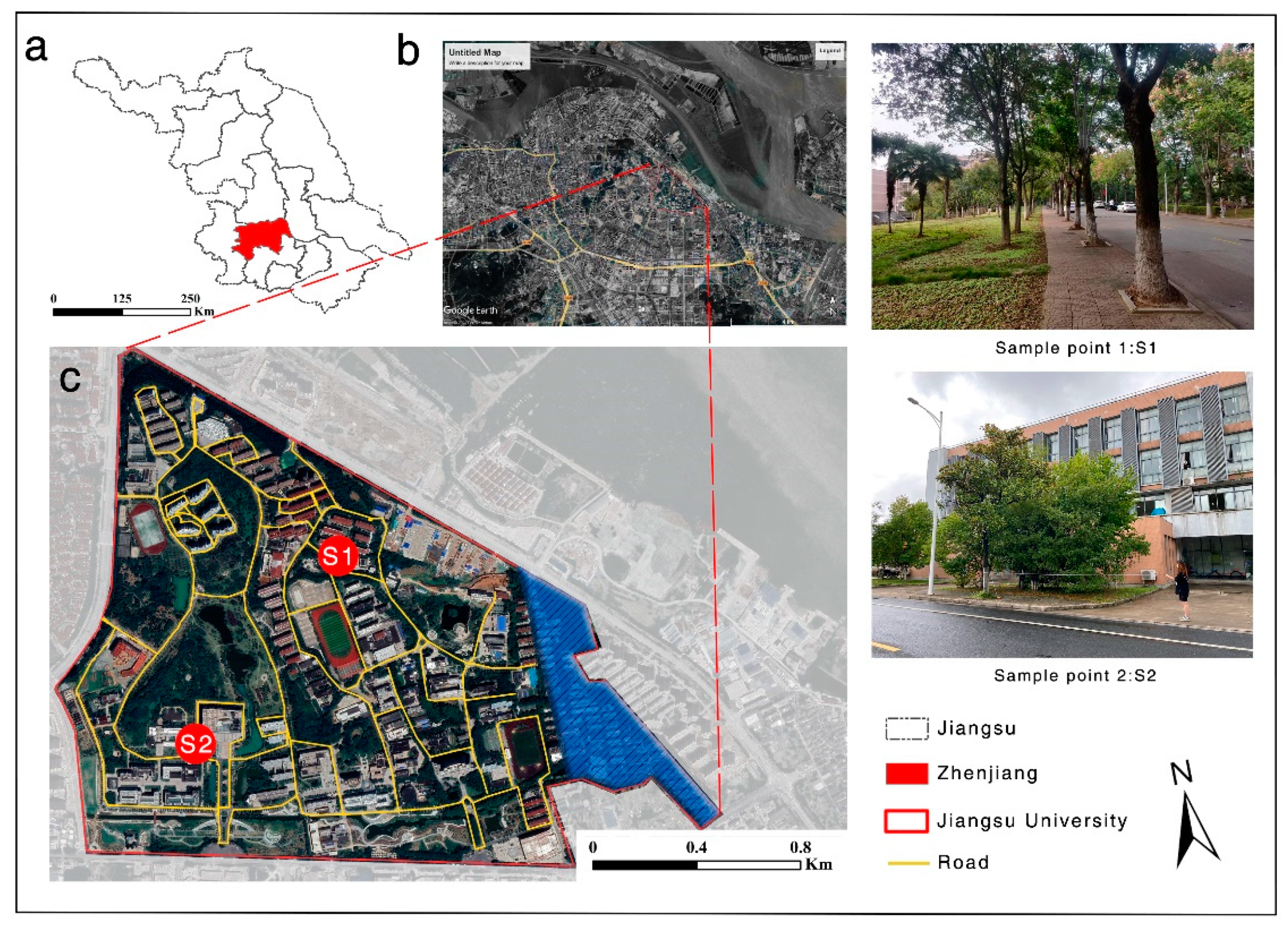
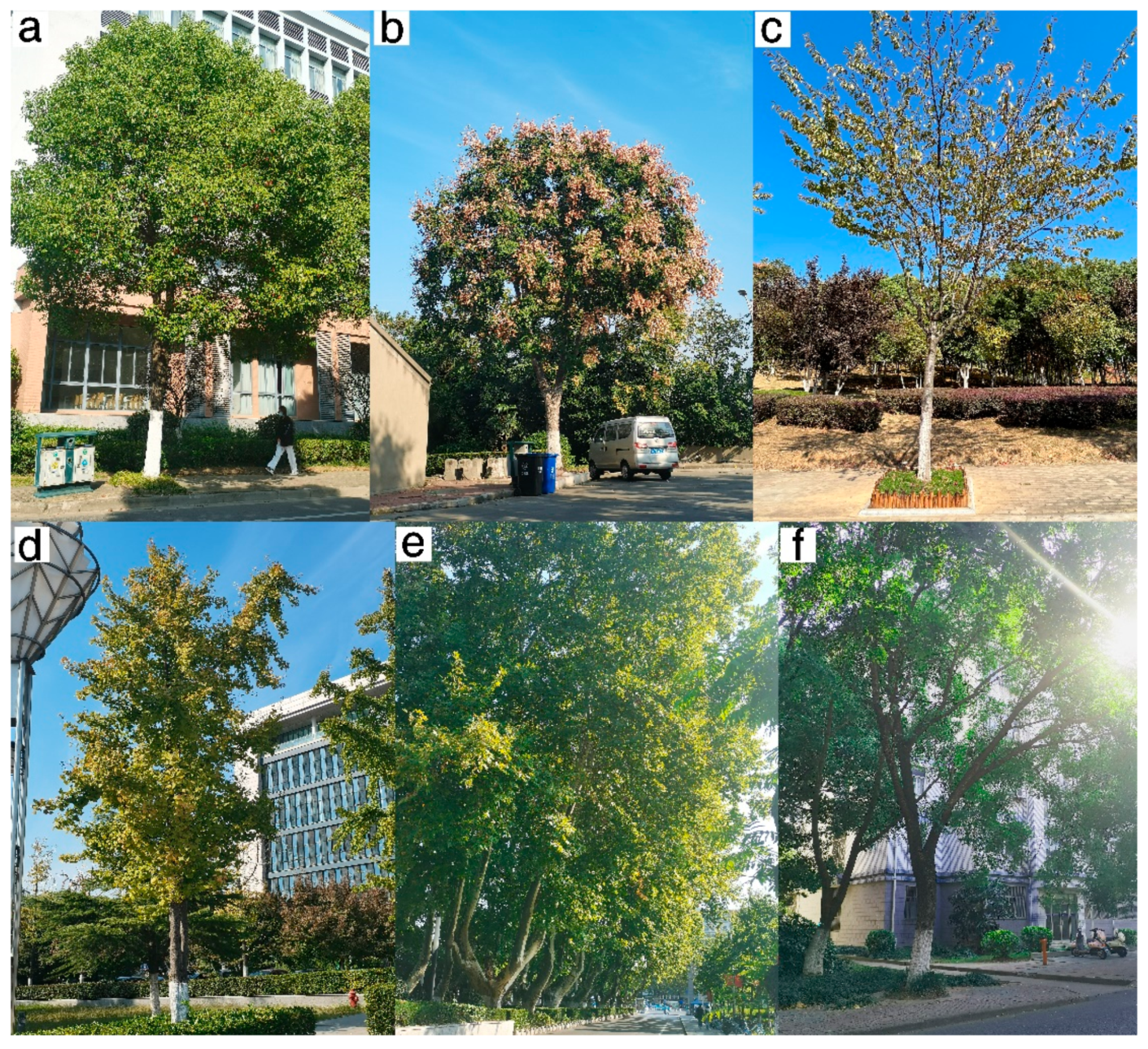

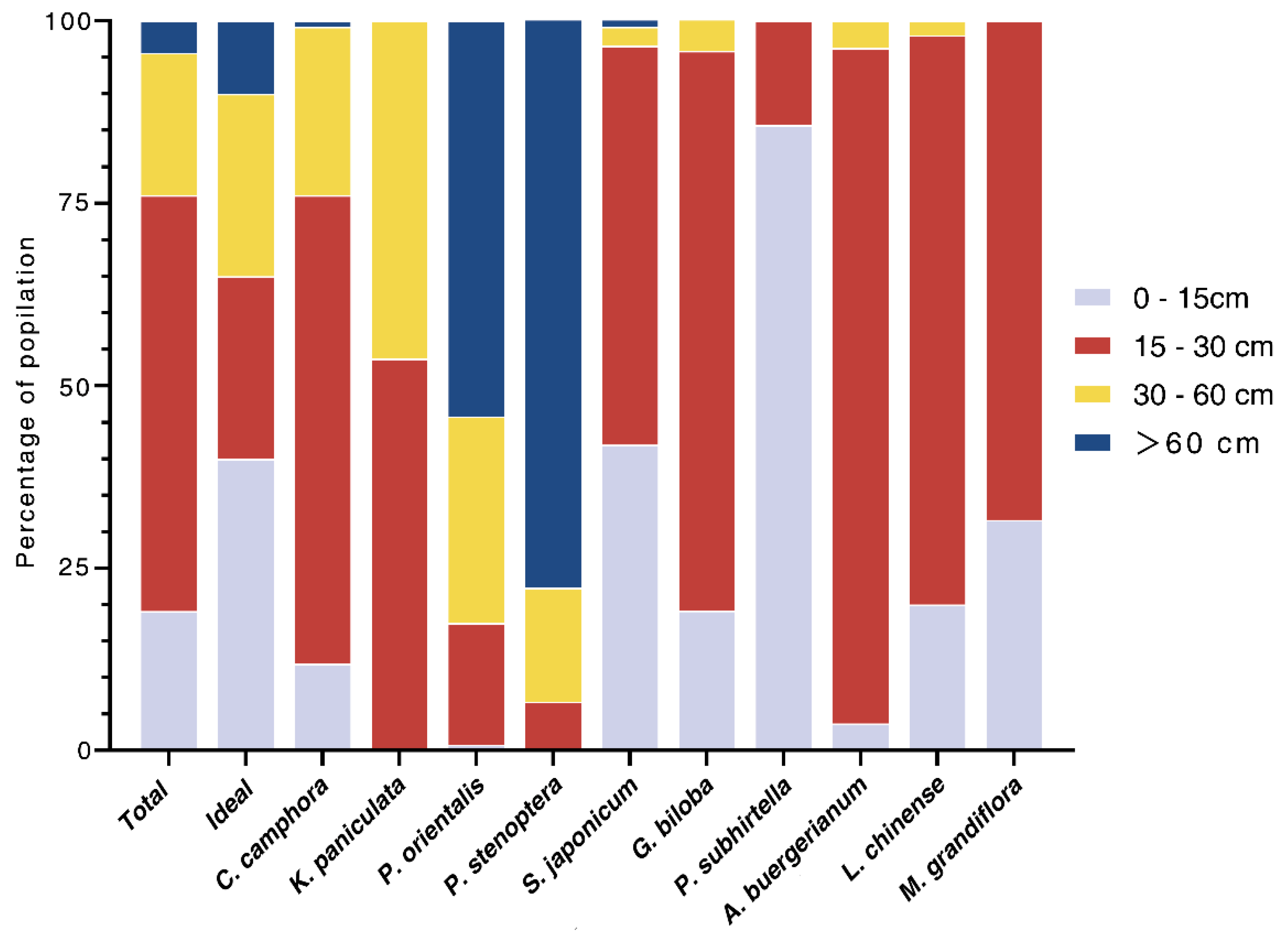
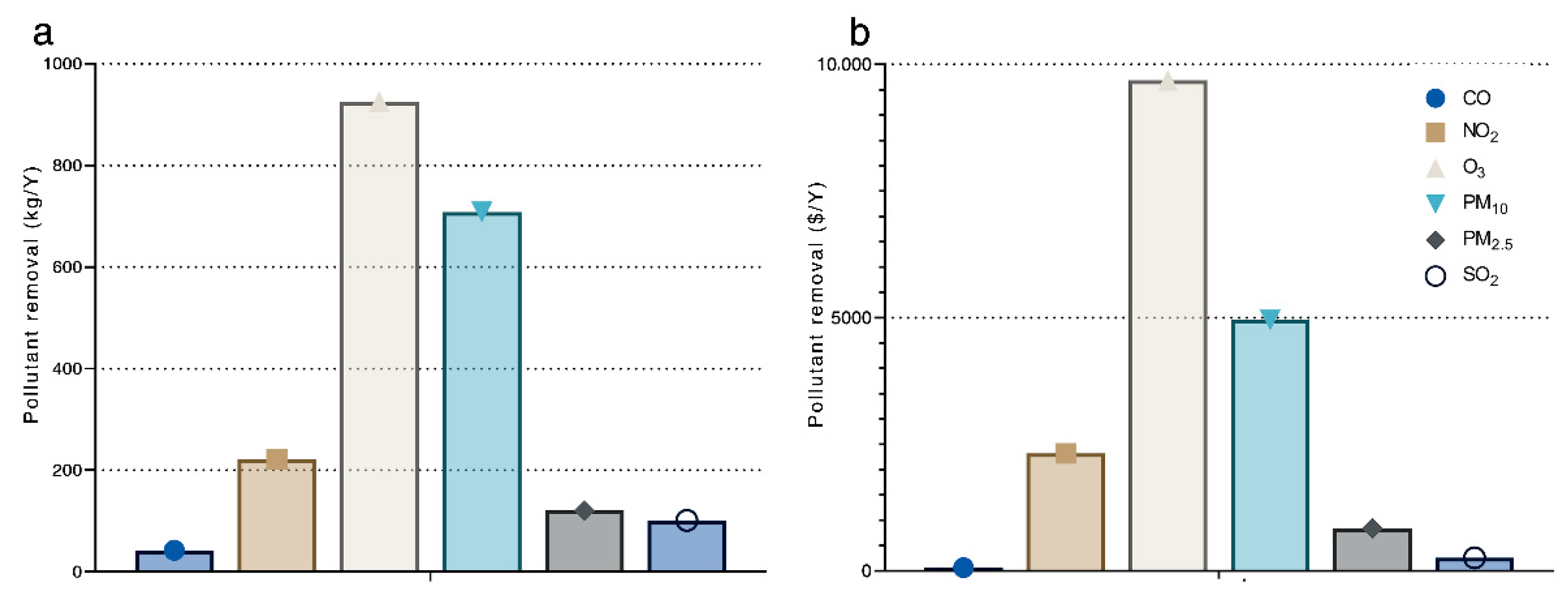
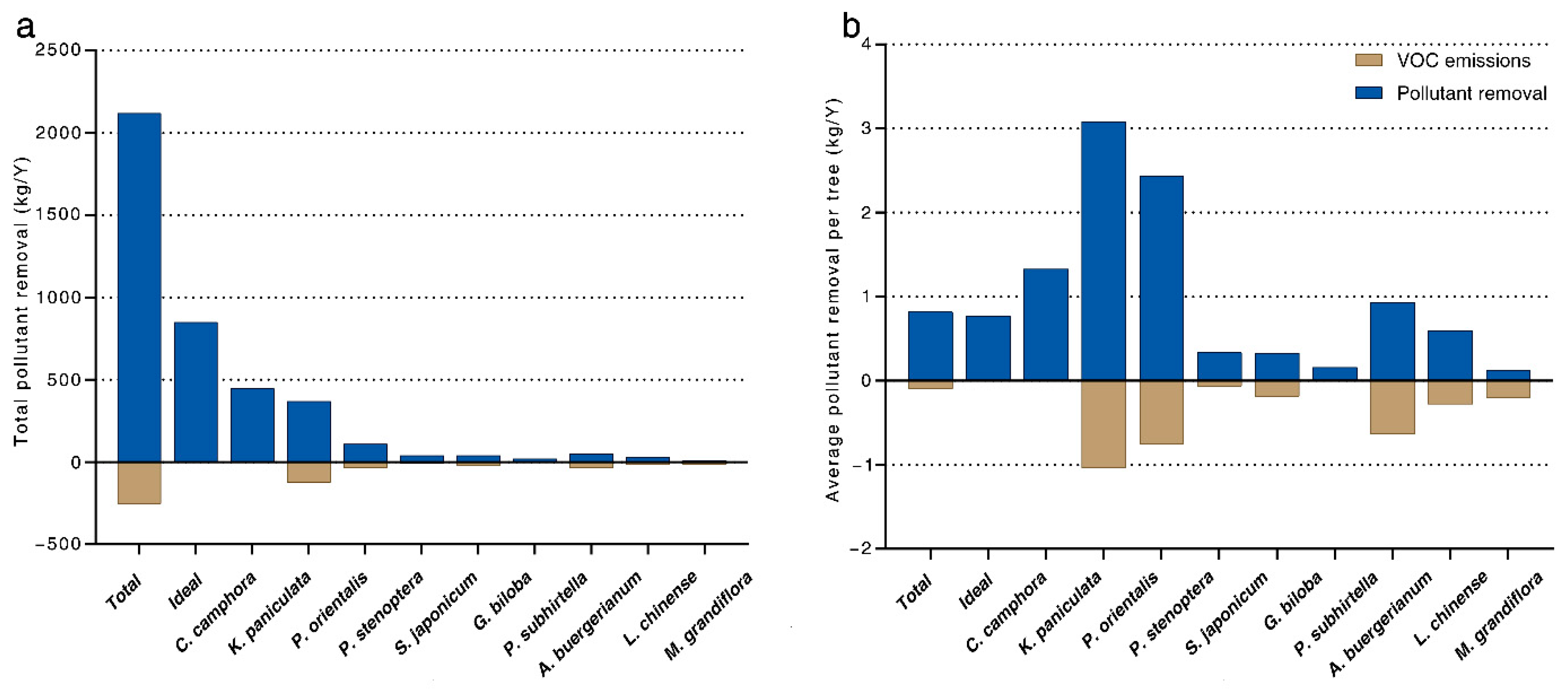

| Species | Total Tree Numbers | Percent Total Tree Numbers | Canopy Cover (m²) | Percent Total Canopy Cover | Leaf Area (m²) | Percent Total Leaf Area | Importance Value |
|---|---|---|---|---|---|---|---|
| Cinnamomum camphora | 1108 | 43.1 | 63,047.0 | 46.6 | 349,309.0 | 40.2 | 43.3 |
| Koelreuteria paniculata | 339 | 13.2 | 29,060.5 | 21.5 | 183,298.5 | 21.1 | 18.6 |
| Platanus orientalis | 120 | 4.7 | 10,899.8 | 8.1 | 150,878.6 | 17.4 | 10.1 |
| Pterocarya stenoptera | 45 | 1.8 | 6458.2 | 4.8 | 43,790.3 | 5.0 | 3.9 |
| Pterocarya stenoptera | 117 | 4.6 | 5371.1 | 4.0 | 18,271.3 | 2.1 | 3.6 |
| Ginkgo biloba | 120 | 4.7 | 2202.9 | 1.6 | 18,154.1 | 2.1 | 2.8 |
| Magnolia grandiflora | 126 | 4.9 | 2078.9 | 1.5 | 6783.2 | 0.8 | 2.4 |
| Acer buergerianum | 54 | 2.1 | 2282.5 | 1.7 | 20,140.3 | 2.3 | 2.0 |
| Liriodendron chinense | 50 | 1.9 | 1202.1 | 0.9 | 11,945.5 | 1.4 | 1.4 |
| Magnolia grandiflora | 79 | 3.1 | 824.0 | 0.6 | 4514.8 | 0.5 | 1.4 |
| Total | 2569 | 135,256.6 | 868,016.2 | 100.0 | 100.0 |
| Carbon Storage (kg) | Carbon Sequestered (kg/Y) | Total Value (USD) | |||||||
|---|---|---|---|---|---|---|---|---|---|
| Species | Avg. | Total | Percent Total | Value (USD) | Avg. | Total | Percent Total | Value (USD) | |
| C. camphora | 295.9 | 327,900 | 49.9 | 61,042.10 | 30.6 | 33,860 | 56.9 | 42,858.60 | 103,900.70 |
| K. paniculata | 363.7 | 123,300 | 18.7 | 22,953.60 | 21.3 | 7220 | 12.1 | 9138.80 | 32,092.40 |
| P. orientalis | 841.7 | 101,000 | 15.4 | 18,802.20 | 38.8 | 4650 | 7.8 | 5885.80 | 24,688.00 |
| P. stenoptera | 646.7 | 29,100 | 4.4 | 5187.70 | 36.4 | 1640 | 2.8 | 2075.80 | 7263.50 |
| S. japonicum | 101.7 | 11,900 | 1.8 | 2215.30 | 17.4 | 2040 | 3.4 | 2582.10 | 4797.50 |
| G. biloba | 45.3 | 5500 | 0.8 | 1023.90 | 3.4 | 410 | 0.7 | 519.00 | 1542.80 |
| P. subhirtella | 43.7 | 5500 | 0.8 | 1023.90 | 14.9 | 1880 | 3.2 | 2379.60 | 3403.50 |
| A. buergerianum | 170.4 | 9200 | 1.4 | 1712.70 | 25.6 | 1380 | 2.3 | 1746.70 | 3459.40 |
| L. chinense | 86.0 | 4300 | 0.6 | 800.50 | 19.4 | 970 | 1.6 | 1227.80 | 2028.30 |
| M. grandiflora | 57.0 | 4500 | 0.7 | 837.70 | 11.3 | 890 | 1.5 | 1126.50 | 1964.20 |
| others | 35,500 | 5.4 | 6838.40 | 4550 | 7.7 | 5759.30 | 12,597.70 | ||
| Total | 657,700 | 100 | 122,438.00 | 59,490 | 100 | 75,300.00 | 197,738.00 | ||
| Species | Pollutant Removal (kg/y) | Pollutant Removal (USD/y) |
|---|---|---|
| C. camphora | 850.0 | 7807.20 |
| K. paniculata | 450.0 | 4096.80 |
| P. orientalis | 370.0 | 3372.20 |
| P. stenoptera | 110.0 | 978.70 |
| S. japonicum | 40.0 | 408.40 |
| G. biloba | 40.0 | 405.80 |
| P. subhirtella | 20.0 | 151.60 |
| A. buergerianum | 50.0 | 450.20 |
| L. chinense | 30.0 | 267.00 |
| M. grandiflora | 10.0 | 100.90 |
| Total | 2120.0 | 18,038.80 |
| Species Name | Avoided Runoff (m³/y) | Avoided Runoff Value (USD/y) | Avg. m³ /Tree | Avg. USD/Tree |
|---|---|---|---|---|
| C. camphora | 946.78 | 306.70 | 0.85 | 0.28 |
| K. paniculata | 496.82 | 1178.90 | 1.47 | 3.48 |
| P. orientalis | 408.95 | 970.40 | 3.41 | 8.09 |
| P. stenoptera | 118.69 | 281.60 | 2.64 | 6.26 |
| S. japonicum | 49.52 | 117.50 | 0.42 | 1.00 |
| G. biloba | 49.21 | 116.80 | 0.41 | 0.97 |
| P. subhirtella | 18.39 | 43.60 | 0.15 | 0.35 |
| A. buergerianum | 54.59 | 129.50 | 1.01 | 2.40 |
| L. chinense | 32.38 | 76.80 | 0.65 | 1.54 |
| M. grandiflora | 12.24 | 29.00 | 0.15 | 0.37 |
| Total | 2352.70 | 5582.60 | 0.92 | 2.17 |
| Benefits | Total Y (USD) | Y (USD)/Tree |
|---|---|---|
| Carbon storage | 128,112.50 | 49.90 |
| Gross carbon sequestration | 11,243.10 | 4.40 |
| Pollution removal | 19,477.00 | 7.60 |
| Avoiding runoff | 5582.60 | 2.17 |
| Total value | 164,415.20 | 64.10 |
Disclaimer/Publisher’s Note: The statements, opinions and data contained in all publications are solely those of the individual author(s) and contributor(s) and not of MDPI and/or the editor(s). MDPI and/or the editor(s) disclaim responsibility for any injury to people or property resulting from any ideas, methods, instructions or products referred to in the content. |
© 2023 by the authors. Licensee MDPI, Basel, Switzerland. This article is an open access article distributed under the terms and conditions of the Creative Commons Attribution (CC BY) license (https://creativecommons.org/licenses/by/4.0/).
Share and Cite
Shen, G.; Song, Z.; Xu, J.; Zou, L.; Huang, L.; Li, Y. Are Ecosystem Services Provided by Street Trees at Parcel Level Worthy of Attention? A Case Study of a Campus in Zhenjiang, China. Int. J. Environ. Res. Public Health 2023, 20, 880. https://doi.org/10.3390/ijerph20010880
Shen G, Song Z, Xu J, Zou L, Huang L, Li Y. Are Ecosystem Services Provided by Street Trees at Parcel Level Worthy of Attention? A Case Study of a Campus in Zhenjiang, China. International Journal of Environmental Research and Public Health. 2023; 20(1):880. https://doi.org/10.3390/ijerph20010880
Chicago/Turabian StyleShen, Guangxi, Zipeng Song, Jiacong Xu, Lishuang Zou, Lijin Huang, and Yingnan Li. 2023. "Are Ecosystem Services Provided by Street Trees at Parcel Level Worthy of Attention? A Case Study of a Campus in Zhenjiang, China" International Journal of Environmental Research and Public Health 20, no. 1: 880. https://doi.org/10.3390/ijerph20010880
APA StyleShen, G., Song, Z., Xu, J., Zou, L., Huang, L., & Li, Y. (2023). Are Ecosystem Services Provided by Street Trees at Parcel Level Worthy of Attention? A Case Study of a Campus in Zhenjiang, China. International Journal of Environmental Research and Public Health, 20(1), 880. https://doi.org/10.3390/ijerph20010880







